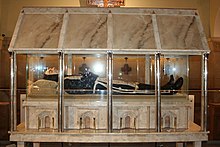Padre Pio Statue
Sainthood and later recognition[edit]
Padre Pio was considered holy even during his lifetime. In 1971 three years after his death, Pope Paul VI said to the superiors of the Capuchin Order about the monk:
| " | Look what fame he had, what a worldwide following gathered around him! But why? Perhaps because he was a philosopher? Because he was wise? Because he had resources at his disposal? Because he said Mass humbly, heard confessions from dawn to dusk and was-it is not easy to say it-one who bore the wounds of our Lord. He was a man of prayer and suffering.[53] | " |
In 1982, the Holy See authorized the archbishop of Manfredonia to open an investigation to determine whether Padre Pio should be considered a saint. The investigation continued for seven years. In 1990 Padre Pio was declared a Servant of God, the first step in the process of canonization.
Beginning in 1990, the Congregation for the Causes of Saints debated how Padre Pio had lived his life, and in 1997 Pope John Paul II declared him venerable. A discussion of the effects of his life on others followed. Cases were studied such as a reported cure of an Italian woman, Consiglia de Martino, associated with Padre Pio's intercession. In 1999, on the advice of the Congregation, Pope John Paul II declared Padre Pio blessed.
After further consideration of Padre Pio's virtues and ability to do good even after his death, including discussion of another healing attributed to his intercession, the pope declared Padre Pio a saint on June 16, 2002.[37] An estimated 300,000 people attended the canonization ceremony.[37]
On July 1, 2004, Pope Saint John Paul II dedicated the Padre Pio Pilgrimage Church, built in the village of San Giovanni Rotondo to the memory of Saint Pio of Pietrelcina.[54] A statue of Saint Pio in Messina, Sicily attracted attention in 2002 when it wept tears of blood.[55]
St. Pio of Pietrelcina is known as the patron saint of civil defense volunteers, after a group of 160 petitioned the Italian Bishops' conference for this designation. The bishops forwarded the request to the Vatican, which gave its approval to the designation.[56] He is also "less officially" known as the patron saint of stress relief and the "January blues," after the Catholic Enquiry Office in London proclaimed him as such. They designated the most depressing day of the year, identified as January 22, as Don't Worry Be Happy Day, in honor of Padre Pio's famous advice: "Pray, hope, and don't worry."[57]
Padre Pio has become one of the world's most popular saints. There are more than 3,000 "Padre Pio Prayer Groups" worldwide, with three million members. There are parishes in Vineland and Lavallette, New Jersey, and Sydney, Australia, and shrines in Buena, New Jersey, and Batangas, Philippines, dedicated to Padre Pio. A 2006 survey by the magazine Famiglia Cristiana found that more Italian Catholics pray to Padre Pio for intercession than to any other figure. (This prayer, more properly understood as a request that the saint intercede to God, is not to be confused with worship, which the Catholic Church teaches is due only to God.)[58]
A statue of Padre Pio will be built on a hill near the town of San Giovanni Rotondo in the southern province of Puglia, Italy, close to the town where he is commemorated. The project will cost several million pounds, with the money to be raised from his devotees around the world. The statue will be coated in a special photovoltaic paint which will enable it to trap the sun's heat and produce solar energy, making it an "ecological" religious icon.[59]

On March 3, 2008, the body of St. Pio was exhumed from his crypt, 40 years after his death, so that his remains could be prepared for display. A church statement described the body as being in "fair condition". Archbishop Domenico D'Ambrosio, Papal legate to the shrine in San Giovanni Rotondo, stated "the top part of the skull is partly skeletal but the chin is perfect and the rest of the body is well preserved".[60] Archbishop D'Ambrosio also confirmed in a communiqué that "the stigmata are not visible."[61] He said that St. Pio's hands "looked like they had just undergone a manicure". It was hoped that morticians would be able to restore the face so that it will be recognizable. However, because of its deterioration, his face was covered with a lifelike silicone mask.[62]
Cardinal José Saraiva Martins, prefect for the Congregation for the Causes of the Saints, celebrated Mass for 15,000 devotees on April 24 at the Shrine of Holy Mary of Grace, San Giovanni Rotondo, before the body went on display in a crystal, marble, and silver sepulcher in the crypt of the monastery.[63] Padre Pio is wearing his brown Capuchin habit with a white silk stole embroidered with crystals and gold thread. His hands hold a large wooden cross. 800,000 pilgrims worldwide, mostly from Italy, made reservations to view the body up to December 2008, but only 7,200 people a day were able to file past the crystal coffin.[64][65][66] Officials extended the display through September, 2009.[67]
Saint Pio's remains were placed in the church of Saint Pio, which is beside San Giovanni Rotondo. In April 2010 they were moved to a special golden "Cripta
